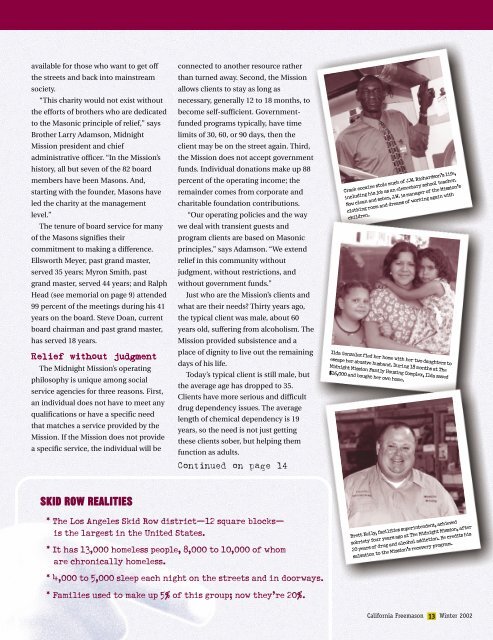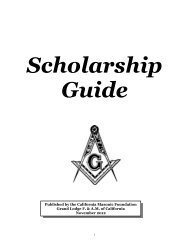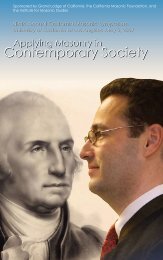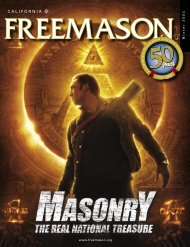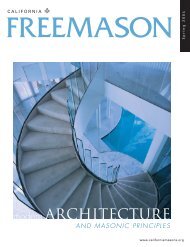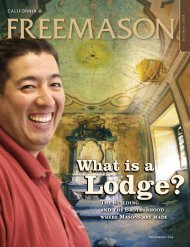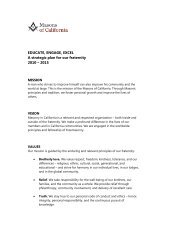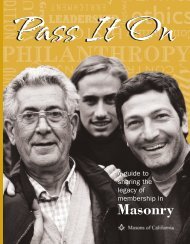Winter 2002 (4.6MB) - Grand Masonic Lodge of California
Winter 2002 (4.6MB) - Grand Masonic Lodge of California
Winter 2002 (4.6MB) - Grand Masonic Lodge of California
You also want an ePaper? Increase the reach of your titles
YUMPU automatically turns print PDFs into web optimized ePapers that Google loves.
available for those who want to get <strong>of</strong>f<br />
the streets and back into mainstream<br />
society.<br />
“This charity would not exist without<br />
the efforts <strong>of</strong> brothers who are dedicated<br />
to the <strong>Masonic</strong> principle <strong>of</strong> relief,” says<br />
Brother Larry Adamson, Midnight<br />
Mission president and chief<br />
administrative <strong>of</strong>ficer. “In the Mission’s<br />
history, all but seven <strong>of</strong> the 82 board<br />
members have been Masons. And,<br />
starting with the founder, Masons have<br />
led the charity at the management<br />
level.”<br />
The tenure <strong>of</strong> board service for many<br />
<strong>of</strong> the Masons signifies their<br />
commitment to making a difference.<br />
Ellsworth Meyer, past grand master,<br />
served 35 years; Myron Smith, past<br />
grand master, served 44 years; and Ralph<br />
Head (see memorial on page 9) attended<br />
99 percent <strong>of</strong> the meetings during his 41<br />
years on the board. Steve Doan, current<br />
board chairman and past grand master,<br />
has served 18 years.<br />
Relief without judgment<br />
The Midnight Mission’s operating<br />
philosophy is unique among social<br />
service agencies for three reasons. First,<br />
an individual does not have to meet any<br />
qualifications or have a specific need<br />
that matches a service provided by the<br />
Mission. If the Mission does not provide<br />
a specific service, the individual will be<br />
SKID ROW REALITIES<br />
connected to another resource rather<br />
than turned away. Second, the Mission<br />
allows clients to stay as long as<br />
necessary, generally 12 to 18 months, to<br />
become self-sufficient. Governmentfunded<br />
programs typically, have time<br />
limits <strong>of</strong> 30, 60, or 90 days, then the<br />
client may be on the street again. Third,<br />
the Mission does not accept government<br />
funds. Individual donations make up 88<br />
percent <strong>of</strong> the operating income; the<br />
remainder comes from corporate and<br />
charitable foundation contributions.<br />
“Our operating policies and the way<br />
we deal with transient guests and<br />
program clients are based on <strong>Masonic</strong><br />
principles,” says Adamson. “We extend<br />
relief in this community without<br />
judgment, without restrictions, and<br />
without government funds.”<br />
Just who are the Mission’s clients and<br />
what are their needs? Thirty years ago,<br />
the typical client was male, about 60<br />
years old, suffering from alcoholism. The<br />
Mission provided subsistence and a<br />
place <strong>of</strong> dignity to live out the remaining<br />
days <strong>of</strong> his life.<br />
Today’s typical client is still male, but<br />
the average age has dropped to 35.<br />
Clients have more serious and difficult<br />
drug dependency issues. The average<br />
length <strong>of</strong> chemical dependency is 19<br />
years, so the need is not just getting<br />
these clients sober, but helping them<br />
function as adults.<br />
Continued on page 14<br />
* The Los Angeles Skid Row district—12 square blocks—<br />
is the largest in the United States.<br />
* It has 13,000 homeless people, 8,000 to 10,000 <strong>of</strong> whom<br />
are chronically homeless.<br />
* 4,000 to 5,000 sleep each night on the streets and in doorways.<br />
* Families used to make up 5% <strong>of</strong> this group; now they’re 20%.<br />
Crack cocaine stole much <strong>of</strong> J.W. Richardson’s life,<br />
including his job as an elementary school teacher.<br />
Now clean and sober, J.W. is manager <strong>of</strong> the Mission’s<br />
clothing room and dreams <strong>of</strong> working again with<br />
children.<br />
Ilda Gonzalez fled her home with her two daughters to<br />
escape her abusive husband. During 18 months at The<br />
Midnight Mission Family Housing Complex, Ilda saved<br />
$16,000 and bought her own home.<br />
Brett Kelly, facilities superintendent, achieved<br />
sobriety four years ago at The Midnight Mission, after<br />
20 years <strong>of</strong> drug and alcohol addiction. He credits his<br />
salvation to the Mission’s recovery program.<br />
<strong>California</strong> Freemason 13 <strong>Winter</strong> <strong>2002</strong>


